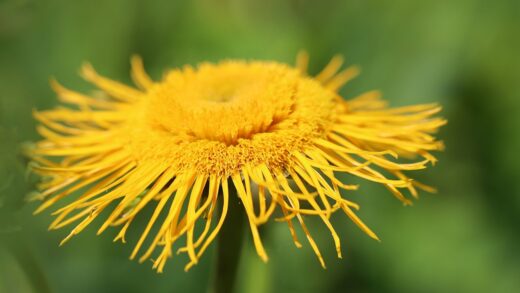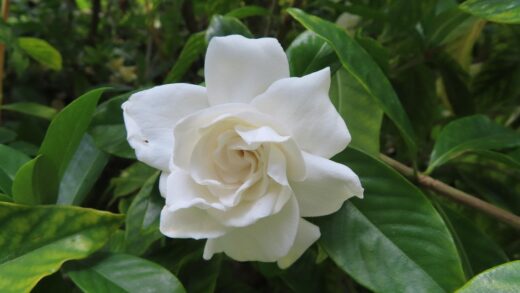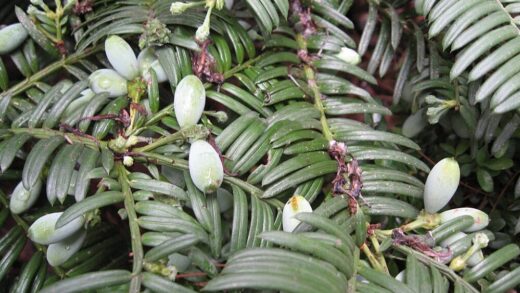While dusty miller is widely regarded as a resilient and largely trouble-free plant, it is not entirely immune to the challenges posed by certain diseases and pests. A proactive approach to plant health, centered on providing optimal growing conditions, is the most effective strategy for prevention. Problems typically arise when the plant is stressed, particularly by conditions that are contrary to its natural preferences, such as excessive moisture, poor air circulation, or inadequate sunlight. By understanding the potential threats and learning to recognize their early signs, gardeners can take swift and effective action to protect their plants and maintain their beautiful, silvery appearance.
The most significant health issues for dusty miller are fungal diseases, which are almost always linked to an excess of moisture. The plant’s dense, felt-like foliage, while excellent at conserving water, can also trap humidity, creating a perfect breeding ground for fungal pathogens if the conditions are right. Root rot, caused by various soil-borne fungi like Pythium and Rhizoctonia, is the most serious and often fatal disease. It occurs when the soil is persistently waterlogged, depriving the roots of oxygen and allowing the fungi to attack and destroy the root system.
Foliar fungal diseases, such as powdery mildew and botrytis blight (gray mold), can also affect the plant, especially during periods of high humidity or when plants are overcrowded. Powdery mildew appears as a white, dusty coating on the leaves, while botrytis causes grayish-brown, fuzzy patches that can lead to tissue decay. Both of these diseases thrive in environments with poor air circulation and damp foliage. Therefore, proper spacing of plants and watering at the soil level are crucial preventative measures.
In terms of pests, dusty miller is not a primary target for most common garden insects, but it can occasionally be troubled by sap-sucking pests like aphids. These small insects tend to congregate on new growth and the undersides of leaves, feeding on the plant’s sap. While a small infestation is unlikely to cause significant harm, a large population can lead to distorted growth, yellowing leaves, and a general decline in the plant’s vigor. Regularly inspecting your plants can help you catch any pest issues early before they become major problems.
Ultimately, the best defense against both diseases and pests is to cultivate a strong, healthy plant. A dusty miller that is planted in full sun, in well-draining soil, and is not overwatered will be far more resilient and less attractive to these potential adversaries. Cultural practices are the first and most important line of defense. Chemical interventions should be considered a last resort, used only when necessary and with careful consideration for their impact on the broader garden ecosystem.
More articles on this topic
Common fungal diseases
Root rot is arguably the most devastating disease that can affect dusty miller. It is not a single disease but rather a condition caused by several different soil-dwelling fungi that flourish in poorly drained, anaerobic (low-oxygen) soils. The symptoms above ground often begin with the yellowing of lower leaves, followed by wilting of the entire plant, even when the soil is moist. The plant may appear stunted and fail to thrive. If you were to gently remove the plant from the soil, you would find that the roots are brown, soft, and mushy, instead of firm and white.
Prevention is the only effective cure for root rot. The disease is almost impossible to treat once it has taken hold. Therefore, all preventative efforts must focus on creating an environment that is inhospitable to these fungal pathogens. This begins with selecting a planting site with excellent drainage and amending heavy clay soils with organic matter and materials like coarse sand or perlite to improve porosity. For container planting, using a high-quality, well-draining potting mix and a pot with ample drainage holes is essential. Above all, adhering to a careful watering regimen that allows the soil to dry out between waterings is the most critical preventative step.
Powdery mildew is another fungal disease that can occasionally appear on dusty miller, particularly in humid weather or in locations with insufficient sunlight and poor air circulation. It is easily identified by the characteristic white, powdery spots that appear on the surfaces of the leaves and stems. While it may not kill the plant outright, a severe infection can reduce photosynthesis, stress the plant, and mar its appearance. To prevent powdery mildew, ensure plants are spaced adequately to promote good airflow and avoid overhead watering, which leaves the foliage wet.
If powdery mildew does appear, there are several control options. For minor infections, simply pruning off the affected leaves may be enough to stop its spread. Increasing air circulation by thinning out surrounding plants can also help. For more established infections, horticultural oils or neem oil sprays can be effective treatments. These products work by suffocating the fungal spores. It is important to apply these treatments according to the label directions and to ensure complete coverage of the affected plant surfaces.
More articles on this topic
Pests to watch for
Aphids are the most likely insect pest you will encounter on dusty miller. These are small, pear-shaped insects that can be green, black, or gray, and they typically feed in clusters on the tender new growth at the tips of the stems or on the undersides of leaves. They use their piercing mouthparts to suck the sap from the plant. A large infestation can cause the leaves to curl, yellow, and become distorted. As they feed, aphids also excrete a sticky substance called honeydew, which can lead to the growth of sooty mold, a black fungus that further detracts from the plant’s appearance.
Fortunately, aphids are relatively easy to control, especially if detected early. For a small number of aphids, a strong jet of water from a hose is often sufficient to dislodge them from the plant. This method is simple, non-toxic, and can be repeated every few days. You can also manually wipe them off with your fingers or a cloth. Encouraging natural predators in your garden, such as ladybugs, lacewings, and hoverflies, is a highly effective long-term biological control strategy. These beneficial insects are voracious predators of aphids.
In cases of a more severe infestation, insecticidal soap or neem oil sprays can be used. These are less toxic options compared to synthetic pesticides and work by smothering the soft-bodied insects. When using these products, it is crucial to achieve thorough coverage, paying special attention to the undersides of leaves where aphids like to hide. Multiple applications may be necessary to control successive generations of the pest. Always apply these sprays in the early morning or evening to avoid scorching the leaves in the hot sun.
While less common, other pests like spider mites or whiteflies might occasionally bother dusty miller, particularly if they are grown in a greenhouse or in very hot, dry conditions. Spider mites are tiny arachnids that cause a stippling or bronzing of the leaves, and you may see fine webbing. Whiteflies are small, winged insects that will fly up in a cloud when the plant is disturbed. The control methods for these pests are similar to those for aphids, with insecticidal soaps and horticultural oils being effective options.
Prevention strategies
The most effective approach to managing diseases and pests on dusty miller is prevention through sound cultural practices. A healthy, vigorous plant is naturally more resistant to problems than one that is stressed. This principle, known as Plant Health Care, focuses on creating an optimal growing environment rather than reacting to problems after they occur. The single most important preventative measure for dusty miller is to ensure it is planted in a location that provides full sun and has exceptionally well-draining soil.
Proper spacing between plants is a critical but often overlooked aspect of disease prevention. When dusty miller plants are placed too close together, air cannot circulate freely between them. This traps humidity around the foliage, creating a microclimate that is ideal for the development and spread of fungal diseases like powdery mildew and botrytis. Following the recommended spacing guidelines for your specific cultivar allows each plant to grow to its mature size with plenty of breathing room, keeping the foliage drier and healthier.
Your irrigation practices play a direct role in disease management. As has been emphasized, overwatering is the primary cause of root rot. Beyond that, the method of watering is also important. Always water the plants at the soil level using a soaker hose, drip irrigation, or a watering can. Avoid overhead sprinklers that wet the dense foliage. If you must use a sprinkler, do so in the early morning so the sun can quickly dry the leaves, minimizing the time they remain wet and vulnerable to fungal spores.
Regular garden sanitation is another key preventative strategy. Throughout the growing season, make it a habit to remove any dead, damaged, or diseased leaves from your plants and the surrounding soil. This reduces the amount of potential inoculum (fungal spores) in the garden. In the autumn, after the first hard frost, it is good practice to clean up and remove the dead plant debris from annual plantings. This eliminates overwintering sites for both pests and disease pathogens, ensuring a cleaner start to the next growing season.
Treatment options
When preventative measures are not enough and a disease or pest problem arises, it is important to choose the most appropriate and least toxic treatment option. For fungal diseases like powdery mildew, early intervention is key. At the first sign of the disease, prune out and destroy the affected plant parts. For more widespread issues, sprays containing potassium bicarbonate or sulfur are effective organic fungicides. Neem oil is also a good choice as it has both fungicidal and insecticidal properties. Always test any spray on a small portion of the plant first to ensure it does not cause any leaf damage.
For severe root rot, there is unfortunately no effective chemical cure for a plant already in decline. The best course of action is to remove and destroy the infected plant to prevent the soil-borne pathogens from spreading to neighboring plants. You should also avoid replanting dusty miller or other susceptible plants in that same spot. Solarizing the soil by covering it with clear plastic for several weeks during the hottest part of the summer can help to reduce the population of pathogens in the soil.
When dealing with insect pests like aphids, always start with the simplest, most mechanical methods of control. A strong spray of water can be surprisingly effective. If the infestation persists, move on to insecticidal soaps. These are specially formulated soaps that are effective against soft-bodied insects but have low toxicity to beneficial insects and mammals. They work by disrupting the insect’s cell membranes. Thorough coverage is essential for them to be effective.
In general, the use of broad-spectrum synthetic pesticides should be avoided in the home garden. These chemicals can kill beneficial insects, such as pollinators and aphid predators, along with the target pest, disrupting the natural balance of your garden’s ecosystem. This can sometimes lead to a rebound effect, where the pest population returns in even greater numbers because its natural enemies have been eliminated. Always opt for targeted, low-impact solutions whenever possible.


















